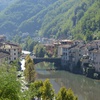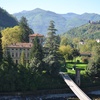Bagni di Lucca (thermal baths)
The beneficial properties of the thermal waters that flow at this location were certainly already known in classical and medieval times, but it was only in the eighteenth and nineteenth centuries that the hot springs of Bagni di Lucca reached their peak of popularity and the village experienced a period of great development.
Among the many great places to visit: the Demidoff hospital, in Ponte a Serraglio, connected by a small bridge to a neo-classical temple; the Church of St. Peter in the small town of Corsena, one of the most interesting examples of medieval Lucca with pictorial works by Giovanni Domenico Ferrucci, Tiberio Franchi, Gaspare Mannucci and Van der Straet, known as “lo Stradano”); the Church of SS. Crucifix in Ponte a Serraglio, built in 1544 and completely renovated in 1930 (inside three works by Pier Filippo Mannucci).
Historical notes
The oldest community in the area, dating from the Middle Ages is Corsena, located on the right bank of the Lima River and associated with the Church of Saint Peter. Castle Corsena, which belonged to the Porcaresi family, was knocked down in 1245 by order of the City of Lucca, for fear that the Emperor Frederick II, during his stay at the Hot Baths, would occupy it. Between the thirteenth and fourteenth centuries numerous small centres of worship were built, often linked to the thermal waters that were so appreciated by nobles, merchants and rulers for their therapeutic properties. A hospital for the poor was also founded and dedicated to Saint John to make sure that even the less well off suffering from various diseases could enjoy the spa treatments.
During the Renaissance, around the establishment at the Bath House, a new village arose that over time grew bigger and bigger around the plain at the foot of the Corsena hill.
Since the nineteenth century, many foreigners seduced by the landscape, the artistic beauty and the thermal benefits of the spa began to spend time in Bagni di Lucca. A small community grew in the village of Anglo-Saxon men and women, many of whom were holidaymakers, who decided to found in Bagni di Lucca their own Protestant church with adjoining cemetery. Many famous people of the time lived there for long or short periods, for rest or for sinful pleasure, and among those of particular notoriety were Paolina Borghese, the popes Sixtus IV and Sixtus V, Queen Margaret, Strauss, Liszt, Puccini, Byron, Lever, Shelley and the writer Ouida.
During this prosperous period, Bagni di Lucca was enriched with several villas (e.g. Ada, Buonvisi, Ducale, Mansi, Palazzo Lena) and buildings that served to entertain the rich nobility and the illustrious writers of the time, to regale them with a frivolous lifestyle of dance parties and sumptuous feasts. In particular, there is the Academic Theatre, the Foreigners Association and a Casino built by Charles Louis de Bourbon in 1836 to satisfy his personal passion for gambling. Thanks to the commitment of English parishioners from Stisted, the architect Giuseppe Pardini concentrated much of his Gothic Revival work here and was responsible for the Tudor style Anglican church and the creation of the English cemetery.










